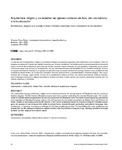Mostrar o rexistro simple do ítem
Arquitectura, religión y sociedad en las iglesias cristianas de Asia: del colonialismo a la inculturación
| dc.contributor.author | Pérez Prieto, Victorino | |
| dc.date.accessioned | 2022-03-28T13:02:24Z | |
| dc.date.available | 2022-03-28T13:02:24Z | |
| dc.date.issued | 2021-12-14 | |
| dc.identifier.citation | Pérez Prieto, V. (2021). Arquitectura, religión y sociedad en las iglesias cristianas de Asia: Del colonialismo a la inculturación. Actas de Arquitectura Religiosa Contemporánea, 8, 50-63. https://doi.org/10.17979/aarc.2021.8.0.8837 | es_ES |
| dc.identifier.issn | 2659-8671 | |
| dc.identifier.uri | http://hdl.handle.net/2183/30287 | |
| dc.description.abstract | [Resumen] La relación entre arquitectura, religión y sociedad configura los espacios sagrados del cristianismo y las religiones. Pero los templos cristianos en Oriente han estado marcados por el estilo occidental. La inculturación es un presupuesto fundamental para el anuncio del cristianismo, pero éste ha venido marcado mayormente por la colonización e imposición de la cultura cristiana-europea más que por la inculturación; con las honrosas excepciones de Matteo Ricci y Roberto de Nobili. Gracias al impulso del Concilio Vaticano II, la Iglesia comprendió mejor su misión de llevar el mensaje cristiano a los pueblos de Asia haciéndolo desde dentro de sus formas culturales: internas (pensamiento y espiritualidad) y externas (lengua, ritos, arquitectura). Sin embargo, sigue siendo un reto de la arquitectura cristiana en Asia. Las bases para hacerla están ya puestas, pero el diálogo arquitectura-religión-sociedad en Oriente aún tiene mucho camino por recorrer, dejándose enseñar por sus valores religiosos y culturales. | es_ES |
| dc.description.abstract | [Abstract] The relationship among architecture, religion and society is present in the sacred spaces of Christianity and the numerous Eastern religions. But the Eastern Christian temples have been marked marked by the colonial Western style. The inculturation is a fundamental presupposition for the announcement of Christianity, but it has been marked mainly by colonization and imposition of Christian-European culture. You will see here the honorable exceptions by Matteo Ricci and Roberto de Nobili. Thanks to the impetus given by the Vatican II, the Church understood better its mission to bring the Christian message to the peoples of Asia doing so from within its cultural forms: internal (thought, spirituality) and external (language, rites, architecture...) However, it remains a challenge for Christian architecture in Asia. The foundations for such architecture are already laid, but the dialogue architecture-religion-society in the East still has a long way to go, allowing oneself to be taught by them, by their religious and cultural values. | es_ES |
| dc.language.iso | spa | es_ES |
| dc.publisher | Universidade da Coruña | es_ES |
| dc.relation.uri | https://doi.org/10.17979/aarc.2021.8.0.8837 | es_ES |
| dc.rights | Atribución-NoComercial-CompartirIgual 4.0 Internacional (CC BY-NC-SA 4.0) | es_ES |
| dc.rights.uri | https://creativecommons.org/licenses/by-nc-sa/4.0 | |
| dc.subject | Matteo Ricci | es_ES |
| dc.subject | Concilio Vaticano II | es_ES |
| dc.subject | Colonización | es_ES |
| dc.subject | Inculturación | es_ES |
| dc.subject | Arquitectura religiosa | es_ES |
| dc.subject | Colonization | es_ES |
| dc.subject | Inculturation | es_ES |
| dc.subject | Vatican II | es_ES |
| dc.subject | Sacred Architecture | es_ES |
| dc.title | Arquitectura, religión y sociedad en las iglesias cristianas de Asia: del colonialismo a la inculturación | es_ES |
| dc.title.alternative | Architecture, religion and society in Asian Christian churches: from colonialism to inculturation | es_ES |
| dc.type | info:eu-repo/semantics/conferenceObject | es_ES |
| dc.rights.access | info:eu-repo/semantics/openAccess | es_ES |
| dc.date.updated | 2022-03-25T13:23:50Z | |
| UDC.journalTitle | Actas de Arquitectura Religiosa Contemporánea | es_ES |
| UDC.volume | 8 | es_ES |
| UDC.startPage | 50 | es_ES |
| UDC.endPage | 63 | es_ES |
| dc.identifier.doi | 10.17979/aarc.2021.8.0.8837 |






